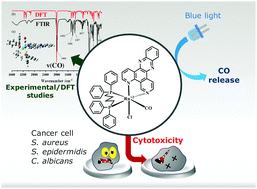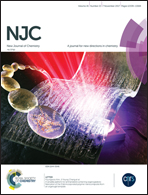A biphosphinic ruthenium complex with potent anti-bacterial and anti-cancer activity†
Abstract
Metal-based compounds have emerged as a novel strategy to improve our arsenal of medicines. Among these compounds, carbon monoxide donor agents have been developed mainly as metal complexes. These compounds have shown exciting biological activities, among them strong anti-inflammatory, antibiotic, and anticancer activity, although some of those properties might be associated with the metal moiety as well. Aiming to prepare a new ruthenium complex containing CO, we prepared a cis-[RuCl(CO)(dppb)(dppz)]PF6 complex (dppb = 1,4-bis(diphenylphosphino)butane and dppz = dipyrido[3,2-a:2′,3′-c]phenazine), which was fully characterized along with DFT studies. This compound exhibited great thermal stability in phosphate buffer solution, but showed fast and efficient release of CO upon light irradiation, including blue LED. Surprisingly, DNA binding was quite weak, despite the dppz ligand moiety, suggesting that steric effects prevented intercalation binding. Nonetheless, this compound exhibited promising antibiotic activity against S. aureus, S. epidermidis and C. albicans in a low micromolar range. However, there was no further improvement upon light irradiation suggesting that there is no role of CO. Additionally, cytotoxicity assay using cancer cells showed quite low IC50 (92 nM, HCT-116) along with moderate to low toxicity assayed in lymphocytes and Artemia. Altogether, these results supported that this compound has great potential as a biological agent, whereas neither CO release nor DNA binding seemed to have a direct role in its activity.



 Please wait while we load your content...
Please wait while we load your content...